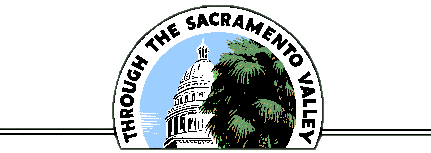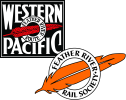THE NORTHERN ELECTRIC'S
HOME-BUILT FLAT MOTORS
In its early years, the Northern Electric handled all its growing freight business with a fleet of home-built motors. Several fine all-steel locomotives provided the heavy freight service. Branches, yards and local freights were worked by a group of six less spectacular all-wood flat motors whose history has largely been ignored by researchers.
The line's first freight motor of any sort was NE 701, also known as "Old Maude". This motor had actually been built in 1904 at the Diamond Match Company plant in Chico for an NE predecessor, the Chico Electric Railway Company. A typical "toolhouse on a raft", 701 had a small cab with side doors centered on its 36-foot, 8-inch flatcar body. There were large windows on either side of the doors, and three windows across each end. A single trolley pole was centered on the cab roof. The motor weighed just over 21 tons. Like all the NE motors to follow, 701 operated at 600 volts DC, and was eventually equipped to take power from a third rail, as well as from overhead wire. "Old Maude" rode on Brill 27E trucks and was powered by four GE 67 motors. In 1913 the motor swapped trucks with streetcar 21 and received a pair of St. Louis 47s. Ira Swett claimed 701 had been equipped with Baldwin trucks at some point, based on an often-printed 1912 picture taken during construction of the Butte Slough bridge. Careful examination of this photo by your editor confirms this was actually one of the later flat motors from the 1002-1004 series.
"Old Maude" was used by the NE on many construction trains in the early days, but was too small to be of much use on the mainline once regular freight service began. The motor was used on the short-lived Hamilton Branch out of Chico in the early days. From around 1915 until at least 1931, NE 701 worked the isolated Suisun-Vacaville branch. When no longer needed at Vacaville, "Old Maude" became a hanger queen in the Chico yard and was scrapped about 1935. Interestingly, 701 was the only former NE motor that was not renumbered in 1928, probably because it was not in conflict with any South End equipment.
"Old Maude" set the pattern for five more motors, though the later units were 41 feet long and the cabs had slightly narrower side windows. All rode on Baldwin 82-30A trucks with four Westinghouse 121A motors that together developed about 360 horsepower. Weights varied (especially with modifications over time), but they tipped the scales at around 40 tons. Most of their electrical equipment was originally mounted below the frame, though as with 701, a large air tank sat on the deck in front of the cab.
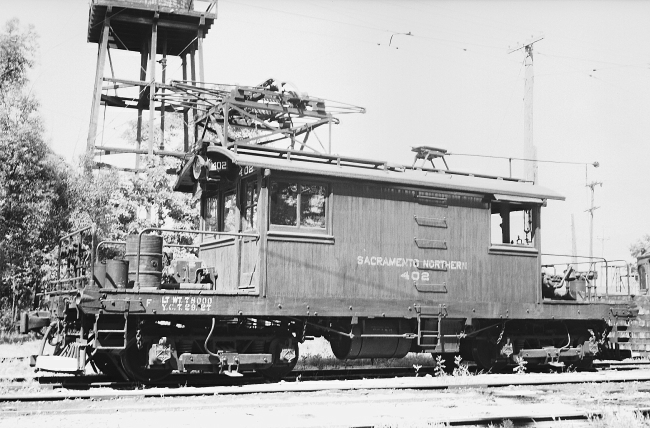
The first of the new motors was numbered 1002, rebuilt from flatcar 1106. It was soon followed by 1003, rebuilt from flatcar 1243. Both entered service in 1907. The career of 1003 was very short. It was destroyed by a fire at Alicia on November 18, 1907. The NE quickly used flat 1149 to build an identical replacement, even recycling the number 1003. Motor 1004 was built from flatcar 1270. Dates of both 1907 and 1908 have been given for its construction.
The last of the flat motors was 1005, which was built in 1914 using flatcar 1131. The cab of 1005 was slightly longer than the others, and most of its electrical equipment was moved inside. A similar cab was applied to 2nd 1003 after it was wrecked on the Oroville Branch in 1916. In 1917, 1002 also received a larger cab, and 1004 had the same treatment in 1919. No photos of these motors during their middle years, have ever been published, so it is not known whether the rebuilt cabs were as they appeared during the 1930s and later, with end doors and a blank wall between two side windows.
The paint color on these motors in the early days has always been a vexing question for historians. Surviving records show that 1003 (1st) was painted in the same yellow-orange used on NE passenger equipment. It is likely that the rest were also painted yellow-orange. In the 1948 edition of SACRAMENTO NORTHERN, Vernon Sappers noted that crews called the motors "yellow bellies" because of their color. In early black-and-white photos the motors appear in a gray tone, a shift caused by the orthochromatic films of the time which were not sensitive to yellows and oranges. With the SNRR reorganization, the motors were repainted Pullman green which also photographed as a gray. According to records, 1005 is known to have been relettered and repainted prior to May 12, 1919. Repaint dates for the others have not been discovered.
Although the flatcars used to build these motors had all-wood underframes, there is ample evidence that as motors their underframes used composite construction, particularly in the prominent bolts which show along the sills in many photographs. The early specification sheets do not mention steel reinforcements. The official 1928 ICC evaluation, however, does indicate composite construction. It is possible that the sills were beefed up with steel channels when the motors were rebuilt with larger cabs before 1920. This is suggested by 1004, which jumped from 76,500 pounds in 1910, to 81,000 in the 1940s. Curiously, 1003 (2nd) dropped from 79,500 pounds in 1910 to 79,000 in the 1940s. In any case, the side sills were always of wood and the motors had truss rods and queen posts for their entire SN service lives.
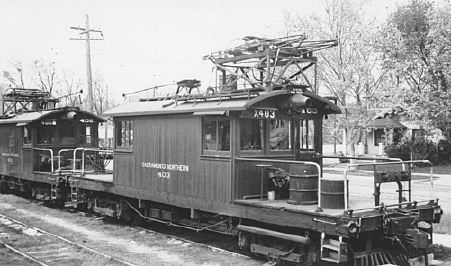
Another important modification was the addition of pantographs. These were perched on towers made from bar and angle stock which were mounted on the front end of the roofs, replacing one pole. When this modification took place is unknown, but from evidence suggested by other locomotives, it happened between the mid-1920s and 1930. Along the way, all four motors received side and end handrails, plus MU connections. With the pending merger between the Sacramento Northern Railroad and the San Francisco-Sacramento Short Line, motors of both lines were renumbered to avoid conflict with passenger cars of the other company. All the Sacramento Northern Railroad's 600 volt motors were renumbered into the unused 400 series in December 1928. Motors 1002-1005 thus became 402-405.
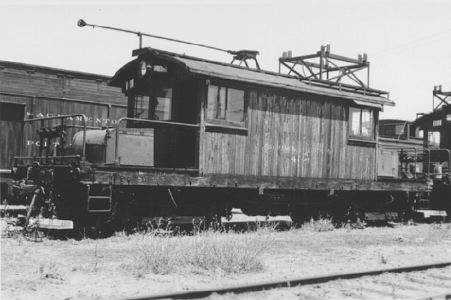
Number 404 became the most modified of the four motors over its long career. It received hoods on each end to protect its compressor and other gear. This made 404 a true steeple cab, the only one of the group to receive this modification. During the 1930s this motor received a set of Hedley trucks, salvaged from the ill-fated parlor car Alabama, which had burned up in 1931.
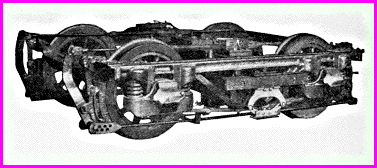
During the Great Depression, business fell off pretty badly on the Sacramento Northern. Most smaller and older equipment ended up on the Chico deadline, including 403, 404 and 405. Numbers 404 and 405 were officially retired at the end of July 1941. It was fortunate that they were still on the property (slowly being stripped for parts), because within a few months the SN would be flooded with military traffic. The two motors were returned to service in June 1942 to assist with the war effort. At that time, 404 lost her Hedley trucks, and was again mounted on Baldwin MCBs.

The Oakland Terminal Railway, a former Key System subsidiary sold to the WP and Santa Fe in 1943, served the huge Oakland Army Base. Millions of tons of military supplies were shipped from here to the Pacific Theater during World War II. The OTRY was simply swamped, and leased several of SN's 600 volt motors, including 404 and 405 beginning in 1943. The SN pantographs and towers were removed and taller Key System pantographs were mounted at roof level so the motors could squeeze through the subway under the SP mainline, but still reach the wire other places. The wooden motors were underpowered and too slow to keep out of the way of the Key System's zippy bridge trains. In 1943, the locomotives were rebuilt with Westinghouse 557A motors saved from scrapped SNRY combines 131 and 132. Motor 405 served the OTRY only until 1945, and 404 came home in 1947. Their places were taken by SN Baldwin motors 440 and 442 which served the OTRY until the line was dieselized in 1955.
With a return to normal traffic after the war and dieselization of parts of the North End, the SN began retiring its older electric motors. Numbers 402 and 403 were sold for scrap to Pollack Wrecking and Steel at the end of 1946. They remained on the Chico deadline for a while, though this time there would be no recall to service. Motor 404 had its SN tower and pantograph restored, and switched around Chico for several years until sold for scrap in June 1950.

This left only 405 in service. It was assigned to the isolated switching stub at Oroville in 1947 (possibly as early as 1945), still sporting its Key System pantograph. SN 405 was repainted with orange scare stripes, the only wooden motor to wear this striking paint scheme. Finally the motor was retired in 1953, though this wasn't quite the end of 405.
The motor was sold to Caldor Lumber Company who used her as a parts source to build a diesel-electric for use at their mill at Diamond Springs, California. She bore the number 1002 and served alongside a similar home-built numbered 1001. The rebuilt engines looked very much like 44-ton Porter center-cabs, though 1002 still rode on her Baldwin trucks. After Caldor Lumber Company went out of business in the late 1950s, both locomotives worked for Winton Lumber Company at Martel, California. Her last known use was in a scrap yard in Portland in the early 1960s.
